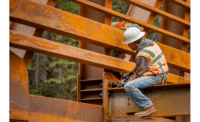Working alone and working at heights for me began years ago as an instrument technician in a large steel mill in western Pennsylvania. We always tried to work in pairs but there were occasions when I had to work alone or apart from my buddy. Working alone at heights in the basket of a lift or tied off on a rooftop is typical for many. On the best day, my comfort was in thinking that I would have my buddy and/or plant protection to respond to a radio call for help.
Suspension trauma
Let’s begin by defining suspension trauma. “Suspension trauma (also known as “harness‐induced pathology” or “orthostatic shock while suspended”) is the development of presyncopal symptoms and loss of consciousness if the human body is held motionless in a vertical position for a period of time.”1
For a deeper understanding, there is a lot of great reading available online. For the purpose of this discussion, let’s keep it short and state simply that bad things happen if you are hanging in a harness for too long.
But how long is too long?
Fall arrest industry experts commonly agree on a time of around 14 minutes, with extreme risk beyond 30 minutes. This window of time is an on-going topic of discussion within the fall arrest industry.
Now, picture yourself working alone and hanging unconscious from a lift or a parapet; not only are you a lone worker, but you are now a lone worker at risk of suspension trauma. All the comfort you thought you had now relies on someone finding you within 14 minutes or less before the effects of suspension trauma begin to put you at risk.
In addition to suspension trauma, lone workers have their own definition:
“A lone worker (LW) is an employee who performs an activity that is carried out in isolation from other workers without close or direct supervision. Such staff may be exposed to risk because there is no one to assist them and so a risk assessment may be required.”2
Lone worker safety systems have been gaining more attention and are being used to satisfy OSHA’s General Duty Clause3. The number of workers working alone is increasing, in part because employers are economically driven to do more with less, leaving workers more vulnerable. A lone worker in distress combined with the risk of suspension trauma requires a method to communicate an immediate notification of the emergency condition followed by an action plan to rapidly dispatch assistance within the shortest window of time.
A good plan
A good lone worker safety plan is one that identifies workers working alone and also includes specific mention of how those working at heights are protected. A good plan will include a method of providing immediate detection and notification of a worker in distress.
OSHA standards are specific regarding fall arrest and in recognizing suspension trauma, as well as the employee’s ability to self-rescue.
Under 29 CFR 1926.502 (d) (Fall Protection Systems Criteria and Practices), OSHA requires employers provide for “prompt rescue of employees in the event of a fall or shall assure that employees are able to rescue themselves. This should include identifying rescue procedures that address the potential for orthostatic intolerance and suspension trauma. Rescue procedures also should address how the rescued worker will be handled to avoid any post-rescue injuries.”4
The fall arrest industry has done a great job in offering products designed to address the need to self-rescue. The ability to perform a self-rescue assumes that the employee is conscious and uninjured.
This raises a good question: What if the employee is incapacitated and not capable of self-rescue?
If this becomes the case, and a worker is unable to self-rescue, then a “prompt rescue of employees in the event of a fall”5 is still required by OSHA 29 CFR 1926.502 (d).
The term “prompt” can be subjective, but it is here where a good lone worker plan can step in to quantify the meaning. Lone worker safety systems are designed to immediately detect a fall or other distress, as well as immediately notify others, regardless of whether the employee is conscious and capable of self-rescue.
Let’s go back to the beginning. This time you are a wearing a lone worker safety device with fall detection. You slip, trip or fall and are hanging from the lift or parapet. You are unable to self-rescue and may be either unconscious or unable to reach the radio. Without the ability to self-rescue you have no idea how long you will be hanging; let’s hope it is less than 14 minutes. This time, because of the lone worker monitoring system, there is comfort in knowing the lone worker device you are wearing will immediately detect your fall and notify others of your distress. The value of immediate notification can be the difference between help arriving within the 14-minute window and hanging with the risk of suspension trauma.
The takeaway
When developing lone worker safety and fall arrest plans, it is a good idea to identify employees using fall arrest systems with the thought that anyone could be working alone, or apart from each other at any time and a risk of being unable to provide a prompt self-rescue. Assigning a lone worker device and considering it to be required PPE along with all other required is a solid solution used to satisfy 29 CFR 1926.502 (d).
Sources






